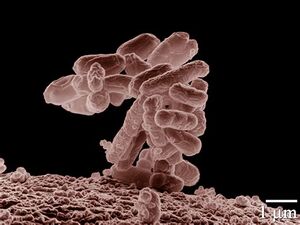Escherichia Whittamii
Classification
Bacteria (Domain); Pseudomonadota (Phylum); Gammaproteobacteria (Class); Enterobacterales (Order); Enterobacteriaceae (Family); Escherichia (Genus)
Species
Whittamii
Description and Significance
E. whittami was named after Thomas S. Whittam(1). He had an extensive career as a researcher during which he studied, among other bacteria, Escherichia coli. One of his biggest contributions to microbiology was an internationally accepted collection of E. coli strains. He also taught at a university and mentored numerous graduate students. Tragically, he passed away in 2008 after being diagnosed with brain cancer (2). The Escherichia genus is named after Theodor Escherich and is composed of several child taxa. The type species is Escherichia coli . The species name whittamii has not been officially accepted (3).
Genome Structure
According to the genome assembly ASM2028370v1, Escherichia whittamii has a genome size of 4.6 Mb and is 50.5 percent GC. It has between 4,359 and 4,341 genes of which 4,031 and 4,167 protein-coding (4).
Cell Structure, Metabolism and Life Cycle
Originally cultured from chicken feces, these bacteria are able to grow at 37 degrees Celsius, making them mesophiles, and under anaerobic conditions. These conditions are similar to the environment the bacteria were cultured from (1).
Ecology and Pathogenesis
Escherichia species are typically found in the intestinal tract of warm-blooded animals. They can be pathogens, but the majority are not. Some species are even beneficial to the host. They are able to use oxygen when available which allows some species to survive outside the GI tract (5). The study E. whittamii was discovered in collected 90 fecal samples from two different breeds of chickens. Cultures from these samples included E. whittamii as well as two other Escherichia species. The relationship between these bacteria are unknown (1).
References
1. Gilroy, R., Ravi, A., Getino, M., Pursley, I., Horton, D. L., Alikhan, N.-F., Baker, D., Gharbi, K., Hall, N. & other authors. (2021). Extensive microbial diversity within the chicken gut microbiome revealed by Metagenomics and culture. PeerJ 9.
2. Abu-Ali, G., Achtman, M., Alm, E., Ammon, A., Bergholz, T., Besser, T., Bielaszewska, M., Bumbaugh, A., Chinen, I. & other authors. (2011). Population genetics of bacteria: A tribute to Thomas S. Whittam. ASM Press.
3. Genus escherichia. In: Genus: Escherichia. https://lpsn.dsmz.de/genus/escherichia. Accessed 12 Dec 2023
4. U.S. National Library of Medicine. (n.d.). Escherichia Whittamii Genome Assembly ASM2028370v1 - NCBI - NLM. National Center for Biotechnology Information. https://www.ncbi.nlm.nih.gov/datasets/genome/GCF_020283705.1/
5. Madigan, M. T., Bender, K. S., Buckley, D. H., Sattley, W. M. & Stahl, D. A. (2018). Brock Biology of Microorganisms, 15th edn. Harlow: Pearson Education.
Author
Page authored by Morgan Harris, student of Prof. Bradley Tolar at UNC Wilmington.

